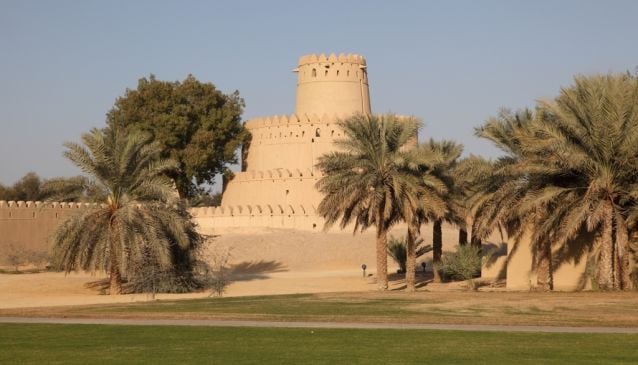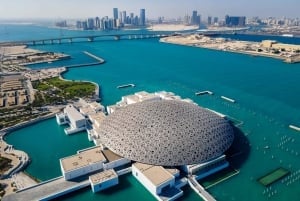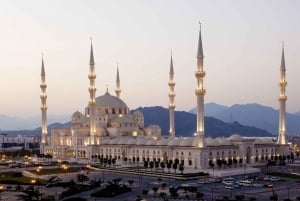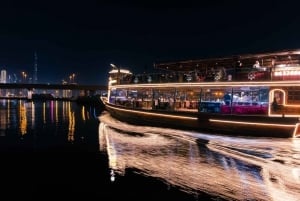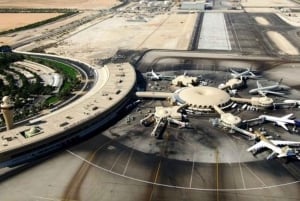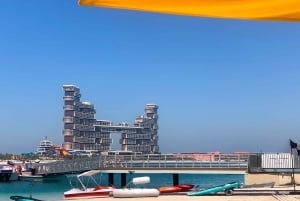Abu Dhabi's Old and New Architecture
Abu Dhabi is a juxtaposition of the impressively new and culturally old...
Book Top Experiences and Tours in Abu Dhabi:
If youʻre booking your trip to Abu Dhabi last minute, we have you covered. Below are some of the top tours and experiences!- Abu Dhabi: Louvre Entry & Etihad Tower/Royal Palace Options
- Dubai: Sheikh Zayed Mosque, Fujairah and Khorfakkan Tour
- Dubai: Luxury Canal Dinner Cruise with Optional Transfers
- From Dubai: Abu Dhabi Grand Mosque & Louvre Museum Full-Day
- Abu Dhabi Airport Transfer to Hotel or Vice Versa
Don’t be mistaken into thinking that is all about the new, the modern and the glitz and glamour of innovative striking sky scrapers full of metal and glass. Well, a lot of it is, and it’s very impressive as it has grown into the cosmopolitan metropolis. But, people forget about the thousands of years of history and heritage that hides behind the shiny tall buildings.
Abu Dhabi is a juxtaposition of the impressively new and culturally old; you just have to look for it. Only in the last 50 years has it changed from an almost barren desert into the metropolis and capital of the UAE we now know. Civilisation started in the third millennium BC, and while buildings don’t date that far back, there is still history within this richly modern city. Explore the modern and the historical of Abu Dhabi through these sites and buildings.
Al Ain Palace Museum
Built in 1910, the palace was the former home of the late UAE founder, Sheikh Zayed Bin Sultan Al Nahyan. Known as the ‘Father of the Nation’, Sheikh lived here from 1937 until 1966. The large sandy coloured building resembles a fort and since 1998 has been a museum. Providing an authentic glimpse into the largely unknown history of the UAE, the museum now houses a large collection of artefacts of the previous ruling family that once lived within its walls. Visit the private rooms of the family and the impressive gardens.
Helix Hotel
The Helix Hotel is perhaps one of the most modern and highly engineered buildings in the world. From the outside, it appears as if bands have been hap-hazzardly thrown over a column and the bands have stayed as they landed. The uneven bands verge out to the left and the right as if the building may be toppling. Inside is a five star luxurious hotel, focusing on the helical floor surface surrounding the undulating void. The hotel was built in 2008 after LEESER Architecture won a bid to design a new hotel in the Zayed Bay District of Abu Dhabi.

Al Jahili Fort
As one of the oldest buildings in the whole of the UAE, the picturesque fort was constructed in 1891. Looking rather much like a large intricate sandcastle built among sand dunes, there are landscaped green gardens behind. The original reason for the fort was to defend the city that was known for its precious pearls and to protect the palm groves. The fort is now well maintained and a major attraction of the city, especially for those seeking culture and heritage. There is also a museum on Wilfred Thesiger, aka Mubrarak bin London, including photographs of his explorations in the UAE during the last century. The fort was also once the residence of the local governor.
Aldar Headquarters
This building is something to literally admire. Its round and spherical shape is the first of its kind in the Middle East. Unsurprisingly, this was voted the ‘Best futuristic design’ building in Abu Dhabi. The spherical shape was achieved by a diagonal grid of steel that is visible on the outside of the building. Located on Al Raha Beach, it stands at 110 meters and looks rather like a ginormous sized bathroom mirror. Inside are 17 elevators, luxurious hotel suites and first class restaurants.

Qasr al-Husn
Qasr al-Husn is the oldest single building in Abu Dhabi. It started out life as a solidity watch tower. The iconic white wash tower, built in 1795, has been expanded and added to over the years with fortification walls. In times of political trouble, the fort provided shelter and refuge for those that needed it most. It was home to the ruling Al Nahyan family
at the time. It became more important during the 19th century once the pearling industry boomed, when canons were added. The tower was not added to again until 1958 when oil was found. For nine years until 1985, it was used for government administrations. 2007 saw its largest expansion and restoration, yet the original tower still stands.
DNA Towers
Still as a project, the aptly named DNA Project Towers get their name from their twisting shape. Looking like an upside down letter ‘U’, the conjoined towers resemble a strand of human DNA; another breakthrough in structural engineering. The towers symbolize the future of Abu Dhabi’s growth, and will be located on Reem Island. Comprising of both residential and commercial property inside, the towers will boast views of the ocean and have the world’s largest infinity pool at its base along with other high class facilities.
The Grand Mosque
Sheikh Zayed Grand Mosque is a beautiful example of Middle Eastern architecture. It resembles its past and represents the east. Tall minarets sit either side of the onion shape domes, while colourful flowers adorn the marble flooring. Although this building looks old, it was only constructed in 2007. Yet, the modern mosque still resembles Abu Dhabi’s cultural history in a way that that many others do not. Middle-eastern archways with columns draped in gold and intricate carvings are all around the walls. The late president of the UAE wanted a structure to unite the cultural diversity of the Islamic world, historical and modern architecture and art. His body has symbolically been laid to rest beside the mosque.



